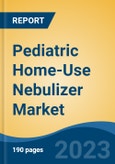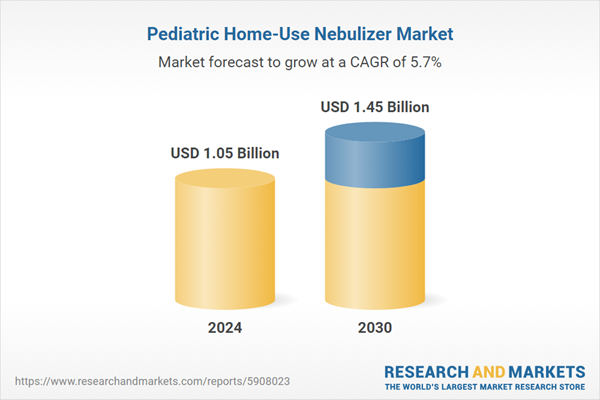Speak directly to the analyst to clarify any post sales queries you may have.
10% Free customizationThis report comes with 10% free customization, enabling you to add data that meets your specific business needs.
Several key factors are driving the growth of the Global Pediatric Home-Use Nebulizer Market. First and foremost, the prevalence of respiratory diseases in children worldwide has been on the rise, necessitating effective and convenient treatment options. As a result, there is an increasing demand for nebulizer devices tailored to children's needs, ensuring precise dosage and ease of use. The technological advancements have led to the development of compact, user-friendly, and quiet nebulizers that are well-suited for pediatric use, fostering greater acceptance among both young patients and their caregivers.
Key Market Drivers
Rising Prevalence of Pediatric Respiratory Diseases
The rising prevalence of pediatric respiratory diseases is playing a pivotal role in boosting the Global Pediatric Home-Use Nebulizer Market. In recent years, there has been a concerning increase in respiratory conditions among children worldwide. Conditions like asthma, bronchitis, cystic fibrosis, and recurrent respiratory infections have become more prevalent, affecting the quality of life for countless young patients. For instance, according to the National Center for Health Statistics, around 8.7% of the U.S. population had asthma in 2022. Additionally, chronic lower respiratory diseases, excluding asthma, accounted for approximately 40.7 deaths per 100,000 people. The expansion of home-based healthcare infrastructure is expected to improve access to nebulizers and emergency care for these patients, contributing to market growth by enhancing respiratory care solutions and patient convenience.Also, a Healthline article from November 2021 stated that ultrasonic nebulizers are unable to deliver certain COPD medications, whereas jet nebulizers can administer all COPD treatments. This versatility of jet nebulizers enhances their demand, contributing to the growth of the segment. This surge in pediatric respiratory diseases has created a significant demand for effective and convenient treatment options. Nebulizer therapy has emerged as a preferred method for managing these conditions, especially among children. Nebulizers convert liquid medications into a fine mist, making it easier for young patients to inhale their prescribed medications directly into their lungs. This delivery method ensures more effective and rapid relief, particularly in emergency situations.
Key Market Challenges
Cost Constraints
The Global Pediatric Home-Use Nebulizer Market has witnessed substantial growth in recent years, offering innovative solutions for pediatric respiratory care. However, a significant obstacle that hinders the broader adoption of these essential devices is cost constraints. The expense associated with pediatric nebulizer devices and related supplies poses a considerable challenge to families and healthcare systems alike.Pediatric nebulizer devices are a crucial component of managing respiratory conditions in children, such as asthma, cystic fibrosis, and bronchitis. These devices convert liquid medication into a fine mist, making it easier for young patients to inhale and receive the necessary treatment directly into their lungs. Nebulizer therapy is effective and often preferable for children due to its ease of use and precision in delivering medication.
However, high-quality pediatric nebulizers, equipped with advanced features and designed with child-friendly elements, can be relatively costly. The initial investment in purchasing a nebulizer device is just one aspect of the financial burden. Families must also factor in ongoing expenses related to maintenance, cleaning, and the purchase of replacement parts and medications. The cost of pediatric nebulizer devices is not limited to families alone. Healthcare systems and insurance providers also face financial implications.
Key Market Trends
Child-Centric Design and Engagement
Child-centric design and engagement are playing a pivotal role in boosting the Global Pediatric Home-Use Nebulizer Market. Manufacturers are increasingly recognizing the importance of creating nebulizer devices tailored specifically to the needs of pediatric patients, and this child-centered approach is driving innovation in the industry.One of the most noticeable trends in nebulizer design is the incorporation of child-friendly elements. These devices often feature vibrant colors, playful shapes, and interactive components that make the treatment process more engaging and less intimidating for children. The inclusion of characters, fun designs, and age-appropriate themes can turn nebulizer sessions into less of a medical chore and more of an enjoyable activity for young patients.
Engagement features in pediatric nebulizers can also include interactive games, sound effects, and animations that capture a child's attention during treatment. These elements not only distract children from the medical aspect of the process but also encourage them to cooperate during nebulizer therapy. When children are actively engaged, they are more likely to sit still and complete their treatments as prescribed, leading to better treatment adherence and improved health outcomes.
Child-centric design extends beyond aesthetics and interactive elements. Manufacturers are also focusing on creating nebulizer devices that are easy to handle, lightweight, and user-friendly for both children and their caregivers. Simplified interfaces and clear instructions make it more straightforward for young patients to operate the devices themselves, enhancing their sense of autonomy and control over their treatment.
Key Market Players
- Omron Healthcare Inc.
- Alfa Medical PA
- Aerogen Ltd.
- Fazzini Srl
- Koninklijke Philips NV
- Lepu Medical Technology Co., Ltd
- Stryker Corporation
- DeVilbiss Healthcare LLC
- Bremed Limited
- Rossmax International Ltd.
Report Scope:
In this report, the Global Pediatric Home-Use Nebulizer Market has been segmented into the following categories, in addition to the industry trends which have also been detailed below:Pediatric Home-Use Nebulizer Market, By Type:
- Electronic Nebulizer
- Pneumatic Nebulizer
- Ultrasonic Nebulizer
Pediatric Home-Use Nebulizer Market, By Application:
- Online Sales
- Offline Sales
Pediatric Home-Use Nebulizer Market, By Region:
- North America
- United States
- Canada
- Mexico
- Europe
- France
- United Kingdom
- Italy
- Germany
- Spain
- Asia-Pacific
- China
- India
- Japan
- Australia
- South Korea
- South America
- Brazil
- Argentina
- Colombia
- Middle East & Africa
- South Africa
- Saudi Arabia
- UAE
- Egypt
Competitive Landscape
Company Profiles: Detailed analysis of the major companies present in the Global Pediatric Home-Use Nebulizer Market.Available Customizations:
With the given market data, the publisher offers customizations according to a company's specific needs. The following customization options are available for the report.Company Information
- Detailed analysis and profiling of additional market players (up to five).
This product will be delivered within 1-3 business days.
Table of Contents
Companies Mentioned
- Omron Healthcare Inc.
- Alfa Medical PA
- Aerogen Ltd.
- Fazzini Srl
- Koninklijke Philips NV
- Lepu Medical Technology Co., Ltd
- Stryker Corporation
- DeVilbiss Healthcare LLC
- Bremed Limited
- Rossmax International Ltd.
Table Information
| Report Attribute | Details |
|---|---|
| No. of Pages | 180 |
| Published | March 2025 |
| Forecast Period | 2024 - 2030 |
| Estimated Market Value ( USD | $ 1.05 Billion |
| Forecasted Market Value ( USD | $ 1.45 Billion |
| Compound Annual Growth Rate | 5.6% |
| Regions Covered | Global |
| No. of Companies Mentioned | 10 |









